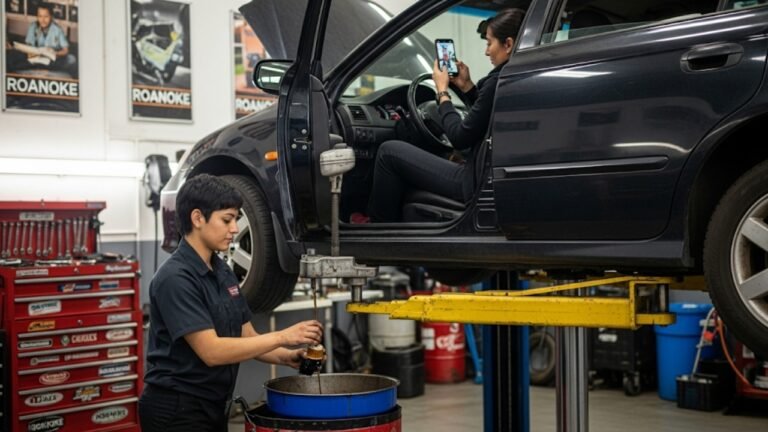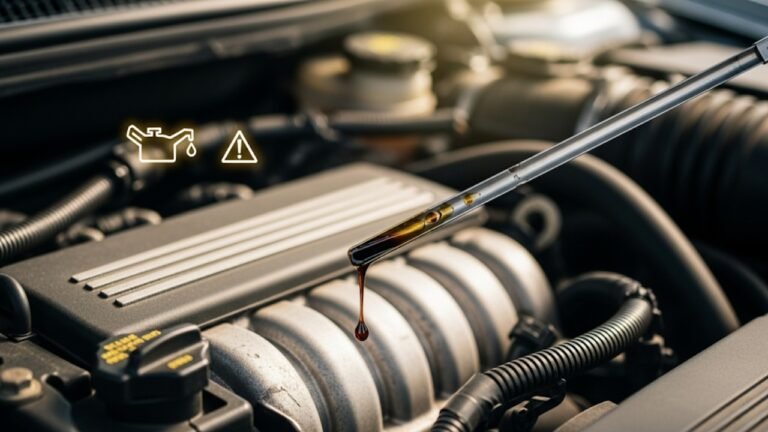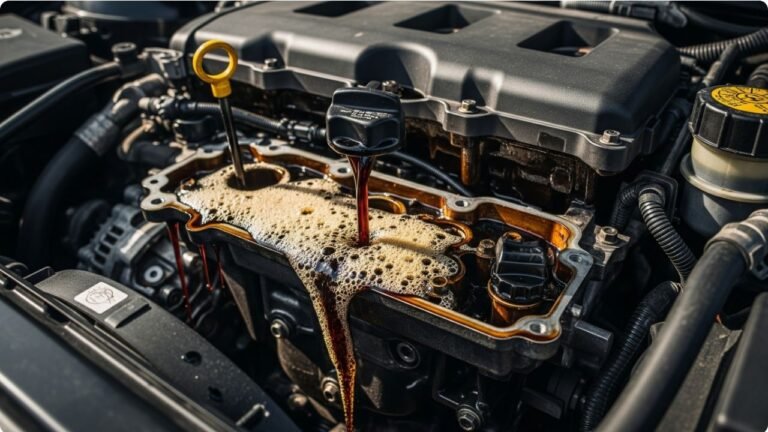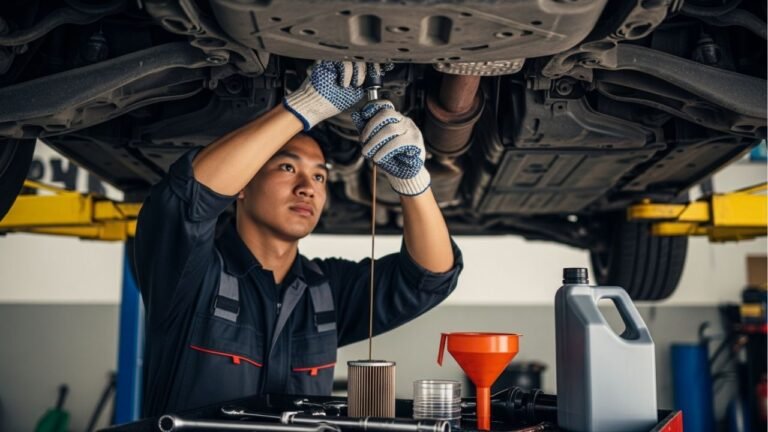How to Stop Oil Leak in Car

There’s a special kind of dread that hits when you spot that brownish puddle under your car. I’ve been there — rushing out the door on a Monday morning, coffee in hand, only to see that ominous drip-stain spreading on the driveway. That’s when the panic sets in: “Is this going to cost me thousands?” or “Will my engine blow up on the highway?”
The truth is, an oil leak in your car doesn’t always mean a financial disaster. But it does need quick attention. Ignoring it can ruin your engine, leave you stranded, and even damage the environment. So if you’re asking yourself, “how to stop oil leak in car”, I’ve got your back. I’ve lived through it, researched it, fixed it myself — and now I’ll walk you through it.
This isn’t just another generic guide. It’s like hearing it from a friend who’s been in your shoes, probably with dirty hands and a heart full of worry. So grab a towel, pop your hood, and let’s tackle this — together.
In This Article
- 1 The Mess Behind the Mystery: What Causes Oil Leaks?
- 2 First Signs: How Do You Know It’s an Oil Leak?
- 3 Don’t Panic: Temporary Fixes for Emergency Situations
- 4 Step-by-Step: How to Stop Oil Leak in Car for Good
- 5 When Oil Leaks Break Your Spirit: The Human Side of Car Troubles
- 6 Eco-Friendly Fixes: Protecting the Earth While Fixing Your Ride
- 7 Oil Leak Severity Table: Know When to Act Fast
- 8 High-Mileage Cars and Oil Leaks: A Love-Hate Relationship
- 9 What If You Can’t Fix It Yourself?
- 10 Final Thoughts: Fix the Leak, Find the Freedom
The Mess Behind the Mystery: What Causes Oil Leaks?

Here are some common causes behind a car oil leak:
-
Worn-out gaskets or seals
-
Loose or cracked oil pan
-
Damaged valve cover gasket
-
Faulty oil filter or oil plug
-
Excess pressure in the crankcase
-
Overfilled engine oil
Honestly, most of my leaks came from gaskets or oil filters. They just degrade with time and heat. And if you park your car in the same spot often, the leak becomes more obvious — you’ll see the stains and smell that burnt-oil scent after a drive.
First Signs: How Do You Know It’s an Oil Leak?
Sometimes, it’s tricky to tell if it’s engine oil, coolant, or just water from your AC. So here’s a quick breakdown from my own garage inspections:
| Fluid | Color | Smell | Texture |
|---|---|---|---|
| Engine Oil | Amber to dark brown | Burnt, greasy | Slick, oily |
| Transmission Fluid | Reddish or pink | Sweet, petroleum-like | Smooth and oily |
| Coolant | Green, pink, orange | Sweet, chemical-ish | Slimy, watery |
| Water (AC) | Clear | Odorless | Watery |
If you rub the fluid between your fingers and it feels slippery and greasy, chances are — it’s engine oil. Check your oil dipstick. If it’s low and you haven’t changed your oil recently, that confirms it.
Don’t Panic: Temporary Fixes for Emergency Situations
When I noticed my first leak years ago, I was broke and terrified. So I learned how to slow it down until I could afford proper repairs. These temporary fixes won’t cure the root problem, but they’ll give you breathing room.
Here’s what helped me:
-
Oil Stop Leak Additives:
Products like Bar’s Leaks or Lucas Oil Stop Leak can condition seals and temporarily plug small leaks. Pour it into your oil reservoir during an oil change. I used this on my old Honda Civic and it bought me 3 extra months. -
Tighten the Oil Filter and Drain Plug:
Sometimes, the oil filter or drain plug just needs a little torque. I once had a mechanic forget to tighten mine — a simple 15-minute inspection solved the mystery. -
Use Engine Degreaser to Spot the Leak:
Clean the area and observe where the oil begins to seep again. I used this trick to spot a leaky valve cover gasket. -
High-mileage oil blends:
These have seal conditioners built in. It’s like moisturizer for your gaskets. Great for cars with 75,000+ miles.
Remember, these are just band-aids. But hey — sometimes a band-aid buys you time until payday.
Step-by-Step: How to Stop Oil Leak in Car for Good
Now, let’s dive into the real solution. This is where you take control and actually fix the leak. I’ll explain it like I’m there with you, under the hood.
1. Locate the Leak
The first step in learning how to stop oil leak in car is finding where it’s coming from.
Tools you need:
-
Flashlight or work light
-
Clean rag
-
Engine degreaser
-
Cardboard (to catch drips)
Steps:
-
Park the car on a level surface and let the engine cool.
-
Use the degreaser to clean oily spots.
-
Run the engine for 5–10 minutes.
-
Watch carefully where fresh oil begins to leak.
Pro tip: If you still can’t find it, sprinkle a bit of baby powder or UV dye around suspected areas. Leaks leave trails.
2. Replace Faulty Gaskets or Seals
If you’ve traced the leak to a valve cover gasket, oil pan gasket, or timing cover seal, it’s time to replace it.
Here’s how I fixed a valve cover gasket on my ‘02 Camry:
What you’ll need:
-
New gasket (get an OEM one if possible)
-
Socket wrench set
-
Gasket scraper
-
Torque wrench
-
RTV sealant (if needed)
Steps:
-
Disconnect the battery.
-
Remove any obstructing components.
-
Take off the valve cover using the wrench.
-
Clean the surface carefully — old gasket bits can cause new leaks.
-
Place the new gasket and re-install the cover using even torque.
-
Wait 24 hours before heavy driving.
Sounds like a lot, but trust me — if I can do it with zero mechanical background and YouTube, you can too.
3. Replace the Oil Filter and Drain Plug Washer
These two are common culprits and are super easy to replace.
Steps:
-
Drain the oil into a pan.
-
Remove the old oil filter (use a filter wrench if it’s tight).
-
Replace it with a new one — don’t overtighten.
-
Replace the crush washer on your drain plug (they’re dirt cheap).
-
Refill oil and check the level.
You might be amazed how many leaks vanish just from replacing a squished washer.
4. Fix the Oil Pan or Plug if It’s Damaged
If the pan itself is cracked or stripped, you’ll need a bit more elbow grease.
-
Cracked oil pan: You can use aluminum epoxy like JB Weld for a temporary seal. Long-term, replace the pan.
-
Stripped drain plug: Install a helicoil kit or get a replacement plug with a larger thread.
I had a stripped drain plug once that leaked like crazy. A mechanic wanted $200 for the fix. I did it myself with a $12 helicoil kit in an afternoon.
5. Maintain and Monitor Regularly
After you’ve sealed the leak, prevention is key. Here’s what I do to keep oil issues from creeping back:
-
Check oil levels weekly
-
Use high-quality oil and filters
-
Change oil every 3,000 to 5,000 miles
-
Inspect under the hood monthly
-
Park in clean spots to check for future drips
It’s just like brushing your teeth — do it regularly and avoid big problems later.
When Oil Leaks Break Your Spirit: The Human Side of Car Troubles
Let me tell you a story.
A few years ago, I was driving through a small village during monsoon season. Rain poured like the sky was letting go of all its sadness. I was in my old Toyota Corolla — she was dependable but aging. Just outside the city, my dashboard lit up like a Christmas tree. The oil warning light blinked angrily.
I pulled over. Looked underneath. My heart dropped. There it was — a steady drip, drip, drip of engine oil, puddling in the mud.
I felt helpless. Angry. Embarrassed. I was 100 miles from home with no tools, no shop nearby, and barely enough money for a tow.
But here’s the thing: cars may break, but we don’t have to. I walked to a roadside mechanic shack — you know the kind, built from corrugated iron and stories. The guy had one good wrench, a smile, and coconut oil on his hands. He showed me how to plug the leak temporarily using soap, tape, and plastic wrap — just enough to get me back home.
That day taught me something important: fixing a car isn’t just about tools. It’s about resourcefulness, patience, and knowing that you’re not alone in the struggle.
Eco-Friendly Fixes: Protecting the Earth While Fixing Your Ride
An oil leak isn’t just your problem — it’s the planet’s too.
Every drop of oil that leaks from your engine has the potential to contaminate soil, kill grass, poison groundwater, or end up in waterways. And it only takes one quart of oil to pollute 250,000 gallons of drinking water.
That’s why stopping leaks matters beyond our wallets. Here’s how you can be more eco-conscious while tackling oil leaks:
-
Use biodegradable engine degreasers when cleaning the leak area.
-
Dispose of old oil, filters, and rags at authorized recycling centers.
-
Use absorbent mats or drip pans to catch oil under your car.
-
Avoid washing oil into storm drains — use a catch tray and soak up spills with cat litter or baking soda.
Taking these small steps shows love not just for your car, but for the ground it drives on.
Oil Leak Severity Table: Know When to Act Fast
Here’s a helpful table I made after years of car DIY experience. It helps you assess how bad the leak is — and whether it’s a “fix now” or “wait a bit” issue.
| Leak Type | Symptoms | Severity | Recommended Action |
|---|---|---|---|
| Minor seepage (dry) | Moist gaskets, no drips | Low | Monitor & address during next service |
| Drip every few hours | Small puddles overnight | Moderate | Add stop leak or plan repair soon |
| Constant dripping | Oil loss daily | High | Fix within days, check level daily |
| Gushing/spraying | Rapid oil loss, smoke from hood | Critical | Stop driving, tow car immediately |
Use this table as your compass — it’ll help you make decisions without panic.
High-Mileage Cars and Oil Leaks: A Love-Hate Relationship
If your car has over 100,000 miles, you’re more likely to deal with oil leaks. I’ve owned a few elderly cars, and let me tell you — they’re like wise grandparents: full of stories, but also full of leaks.
Here’s why high-mileage engines tend to leak:
-
Gaskets dry out with age.
-
Heat cycles wear out seals.
-
Sludge build-up increases crankcase pressure.
-
Older engines weren’t built for modern synthetic oils.
But don’t lose hope. With the right care, you can still keep your high-mileage buddy running strong.
Pro tip: Use high-mileage synthetic oil with seal conditioners. Brands like Castrol, Valvoline, and Mobil 1 have special formulas designed for aging engines.
And if you’re wondering how to stop oil leak in car that’s been leaking forever — sometimes, the answer is slow it down, not stop it completely.
What If You Can’t Fix It Yourself?
Not everyone has tools, space, or the physical ability to crawl under a car. That’s okay. I’ve been there — living in a cramped apartment, borrowing my neighbor’s wrench set just to tighten a bolt.
If a DIY fix feels out of reach:
-
Visit a trustworthy mechanic: Look for local reviews, ask friends, or even check Reddit or Facebook groups.
-
Get a second opinion: Some shops overestimate repair costs. Don’t say yes until you’re sure.
-
Prioritize safety: If oil is leaking onto a hot exhaust, that’s a fire risk. Get help fast.
You’re not less of a car owner because you can’t fix it yourself. Asking for help is its own kind of strength.
Final Thoughts: Fix the Leak, Find the Freedom
At the end of the day, learning how to stop oil leak in car is more than just a mechanical task. It’s about reclaiming control. It’s about not letting small problems grow into big ones. It’s about understanding the heart of your vehicle — and maybe even the heart of yourself.
I’ve learned a lot from oil leaks. Patience. Ingenuity. Even a little humility.
And while it’s easy to see them as a burden, sometimes they’re just a reminder to slow down, pay attention, and take care of what we rely on every day.






